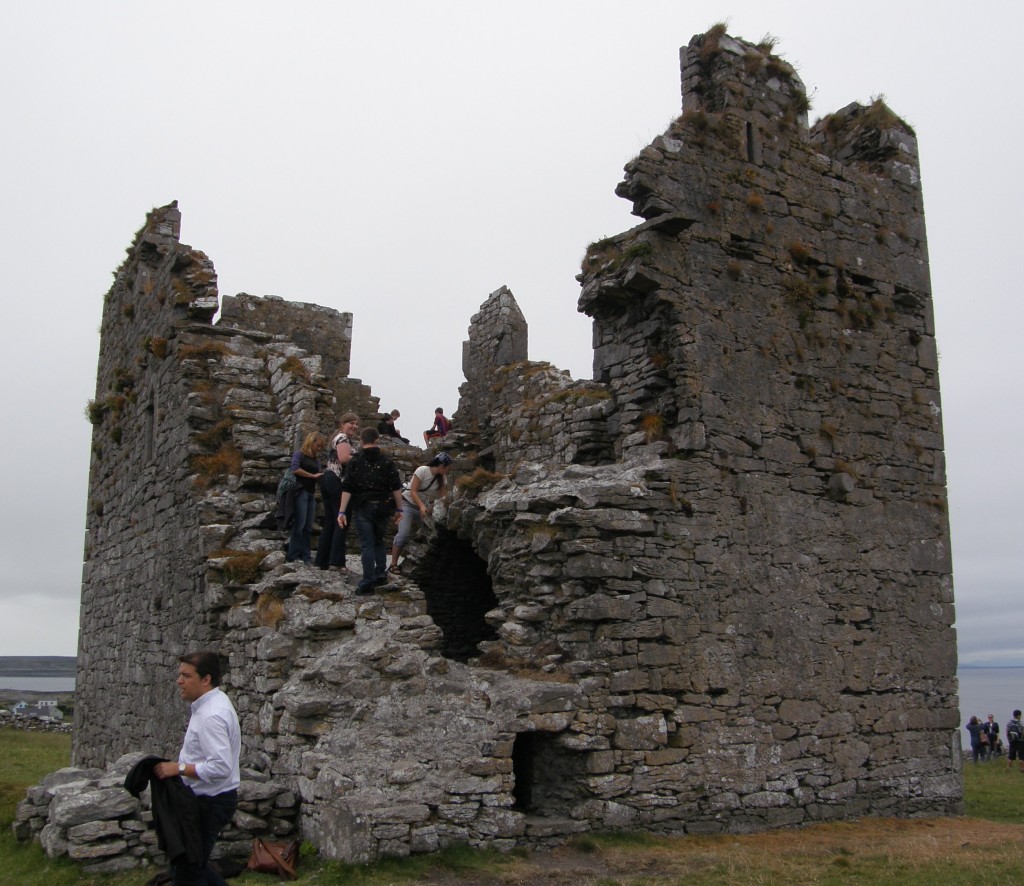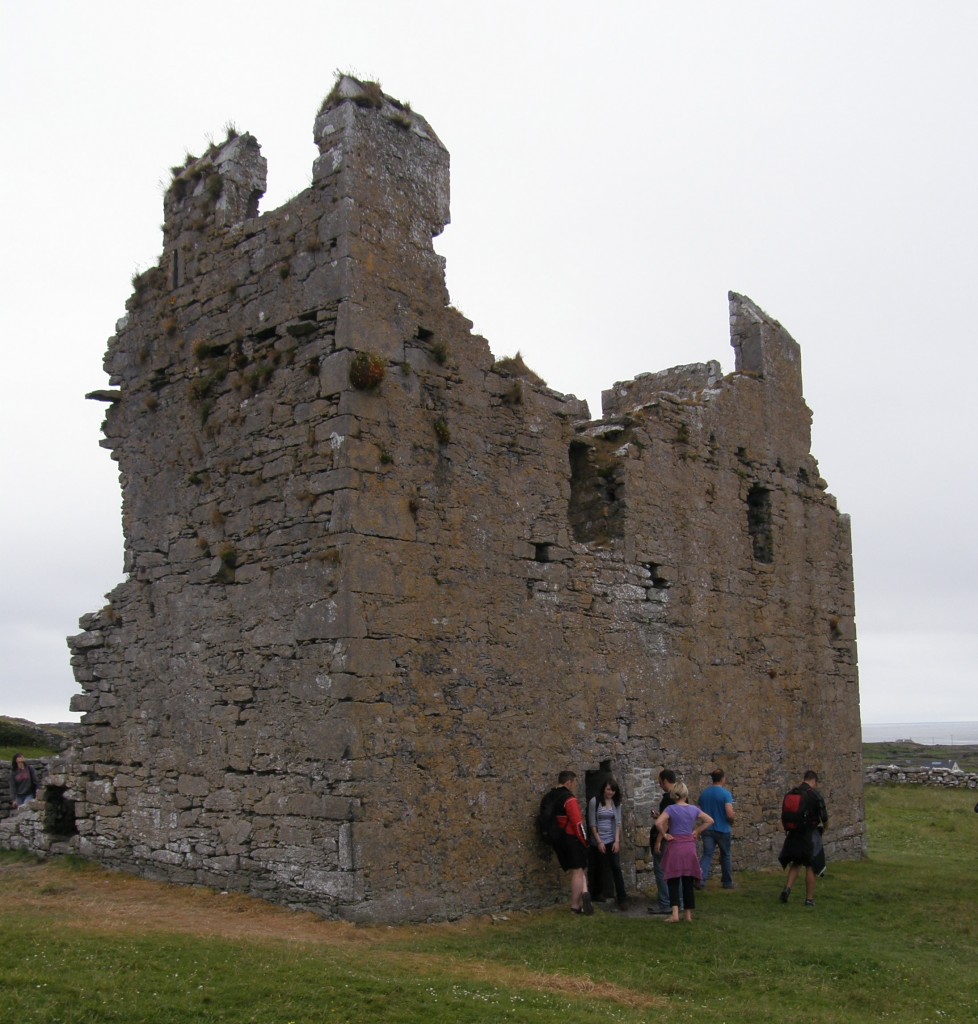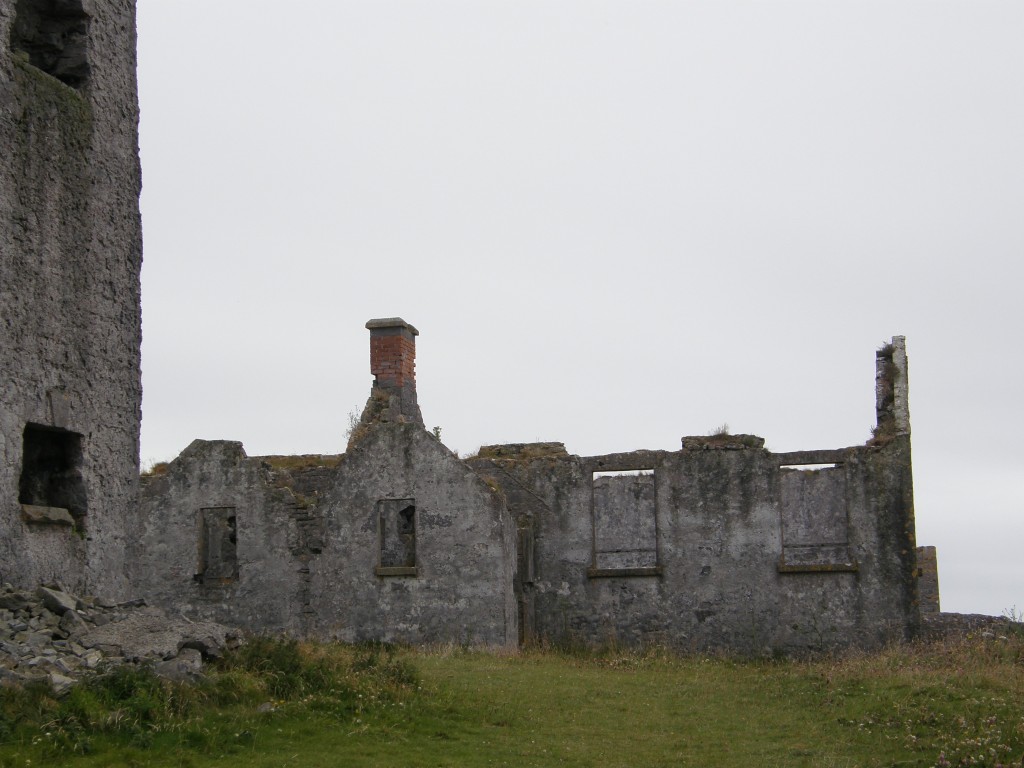On Saturday, 23 July 2011, the students of the Acadamh na hOllscolaíochta Gaeilge boarded a bus, traveled 45 minutes to Ros á Mhil, boarded a ferry (Banrion na Farraige, “Queen of the Sea”) and journeyed to the smallest of the Aran Islands. Inis Oírr (Inisheer), a name derived from Inis Oirthir meaning “island of the east”, is the most eastern of the islands. About 3 square kilometres in size, Inis Oírr is a walker’s paradise. Posts with a “walking man” symbol mark a route around the island which can be completed in about four hours; we didn’t have quite that amount of time and covered only about half of the trail.
The island is a limestone pavement rising to a highest point of 60 meters above sea level. The flora and fauna include many extremely rare species, some of which are under conservation order. Fifty-seven species of birds, thirty-two kinds of wildflower and grass (including a species of darnell grass and one of cornflower found nowhere else), and three types of bumblebee share the island with about 250 human beings.
Inis Oírr has been inhabited for more than 5,000 years; arrowheads and flint from the Stone Age have been recovered at various locations on the island. Later evidence, from the Bronze Age, comes from urns and bones excavated at a burial site called Cnoc Raithní (“hill of ferns”).
Christianity came to the islands before the end of the first millennium. Near the swimming beach next to the ferry pier is the island’s graveyard. Here one finds the buried church called Teampall Chaomhain (“St. Caomhan’s church”). This is a 10th Century church said to have been founded by St. Caomhan (“Kevin”), a disciple of St. Enda the Patron Saint of the Aran Islands. (This St. Kevin is said to be the older brother of the St. Kevin who founded the monastic community at Glendalough.) The church was nearly buried by drifting sands, but has now been excavated and is kept clear of sand by the residents. It is a beautiful and peaceful place looking out over the ocean.
Further inland is Cill Ghobnait (“St. Gobnait’s church”) or Teampall Beag (“small church”) which was built in 11th Century and is dedicated to Saint Gobnait. It is built on a site which may have had an early church from before the 9th Century and does include the remains of a clochán or hermit’s beehive cell. Although Saint Gobnait is linked to Ballyvourney in County Cork, she is believed to have been a native of County Clare (the closest mainland county to the islands). The islanders believe she fled to Inis Oírr and lived in the clochán. (What she may have been fleeing from, we were not told.) Around the ruins of the church here three outdoor altars (which may mark graves), two bullaun stones, and the clochán. (Bullaun stones are basically holy water fonts. Local folklore often attaches religious or magical significance to them, including the belief that rainwater collecting in a bullaun stone’s hollow has healing properties.)
In medieval times, the Aran Islanders lived in “chiefdoms”, the largest example of this is the hillfort at Dún Aonghasa on Inis Mór. The Aran Island chiefs were powerful and wealthy men who controlled the western sea passages; they contracted with the merchants of Galway keep the approaches to Galway Bay free from pirates in exchange for protection money, but apparently were not against a bit of pirating themselves. The islands became known as a haven for foghlaí mara (“sea plunderers”, i.e., pirates).
In the 14th Century, Inis Oírr became a base of the powerful O’Brien family and Caislean Uí Bhriain (“O’Brien’s Castle”) on was built here. The castle was taken from the O’Briens by the O’Flaherties of Connemara in 1582. It was occupied by them and others until 1652, when the Aran Islands were surrendered to Cromwellian forces.
In the early 19th Century, it was feared that Napoleon might invade Ireland and watchtowers and Martello towers were built all around the island nation, including a watchtower on Inis Oírr. The French never came and the watchtower became a school and an additional building was built next to it. Children would be schooled for the first several years in this local school and then would travel by boat to schools on the other islands or to the mainland.
Inis Oírr’s history is strongly linked to the sea; the sea provided food for islanders to live on, and protected them from famine. The cargo vessel Plassey was shipwrecked off Inis Oírr in the 1960s, and has since been thrown above high tide mark at Carraig na Finise (a beach) on the island by strong Atlantic waves. The islanders rescued the entire crew from the stricken vessel, the wreckage of which has become a tourist attraction on the island. Unfortunately, with our limited time we were unable to see the ship wreck.
This marks my third visit to the Aran Islands. Evelyn and I visited Inis Mór, the largest, in 2007; I visited Inis Meán with another class from the language school in 2008; and I have now made this visit to Inis Oírr. Although the 21st Century has certainly come to these islands (automobiles and diesel tractors are found on all of them; cell phone reception is superb; one assumes the residents have access to the internet), there is still something timeless and ancient about them. Life clearly moves a different pace. Travel writer A.J. Neudecker has said that “Little Inisheer … is bottled tranquility.” I can see how two or three days on this island would be very restful!












Great post. Shared it on the Aran Islands Facebook page.
sounds like a fantastic trip. i can easily see myself spending a few days in Inis Oirr…
Alana – you’d really like the Aran Islands!
John – what’s the Facebook page id?
Thanks, Eric
Eric, What a wonderful display of stone work. The art of placing stones like that is breathtaking. Reminds me of the stone walls at Stan Hyett in Akron, when they had to do repairs on some of them, they said it took some searching to find a craftsman who could do it.
Again, thank you for this sharing of your journey.
Can you please contact me at my @; I have few questions concerning the church and the history of Cill Ghobnait .
Thank you for your help.
Kindest regards
Gerald Perrotton
Connemara
Gerald, I’ve sent you a message. Eric